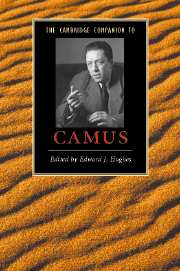Book contents
- Frontmatter
- Introduction
- PART I: BIOGRAPHY AND INFLUENCES
- PART II: THEMES, PREOCCUPATIONS AND GENRES
- PART III: TEXTS AND CONTEXTS
- 11 From Noces to L’Etranger
- 12 Layers of meaning in La Peste
- 13 Withheld identity in La Chute
- 14 Le Premier Homme and the literature of loss
- Postface
- Guide to Further reading
- Index
- Series List
13 - Withheld identity in La Chute
from PART III: - TEXTS AND CONTEXTS
Published online by Cambridge University Press: 28 September 2007
- Frontmatter
- Introduction
- PART I: BIOGRAPHY AND INFLUENCES
- PART II: THEMES, PREOCCUPATIONS AND GENRES
- PART III: TEXTS AND CONTEXTS
- 11 From Noces to L’Etranger
- 12 Layers of meaning in La Peste
- 13 Withheld identity in La Chute
- 14 Le Premier Homme and the literature of loss
- Postface
- Guide to Further reading
- Index
- Series List
Summary
Following upon four years of near silence after the controversy with Sartre in Les Temps modernes surrounding the disputed philosophical claims of L'Homme révolté, the publication in 1956 of La Chute dispelled any premature notion that Camus might have lost his considerable talents and intellectual relevance as a writer. In a tightly structured imaginative fable centred in an examination of human duplicity remarkable for its mixture of lucidity and ferocious wit, Camus made his return to centre stage both assertive and enigmatic. Of all Camus's texts, and in contradistinction to the outspoken straightforward presentation of Le Premier Homme which was to follow it, La Chute is the most resistant to our understanding as readers, for two essential reasons: (1) it is highly personal; its rhetorical mode is that of a monological confession; and (2) it eludes our grasp by alluding to numerous other works of literature in the Western tradition, from the Bible through Dante to Dostoyevsky, to such a degree that we have difficulty separating levels of meaning in an effort to attain the work's semantic core. Of all Camus's texts, La Chute has generated the broadest diversity of critical readings precisely because of the apparently uncontrollable multiple meanings that inhere within its personal and allusive potential.
- Type
- Chapter
- Information
- The Cambridge Companion to Camus , pp. 178 - 190Publisher: Cambridge University PressPrint publication year: 2007
- 3
- Cited by

